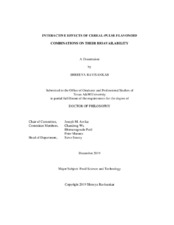| dc.description.abstract | Cereals and pulses are consumed together in several cultures. They contain complementary flavonoid structures, that, in a previous study, showed synergistic downregulation of inflammation in CCD-18Co cells. However, the mechanisms of the observed effect are unknown. Further, there are gaps in knowledge on flavonoid profiles in cereals and effect of processing on the flavonoids. The goal of this study was to evaluate the interactive effects of cereal-pulse flavonoid combinations on their bioavailability, which is an important determinant of bioactivity. The absorption properties of flavonoid combinations were determined in Caco-2 monolayer model. Structural variation of flavonoids in different cereal grains was evaluated using ultra-performance-liquid-chromatrography-tandem-quadrupole-massspectrometry. Lastly, effect of fermentation and baking (pancakes) on different flavonoid structures in grains was evaluated. Apparent absorption of quercetin and apigenin (representing flavonols-flavones predominant in pulses-cereals) increased 3.3 and 1.5 times respectively, and they metabolized to a lesser extent in combined treatments vs individual treatments. Combinations with naringenin (flavanone present in cereals) had an insignificant effect, suggesting a role for flavonoid C2=C3 double bond conjugation. Further, apigeninquercetin combinations inhibited P-glycoprotein ATPase activity by 40-66% suggesting direct binding to ABC transporters. Thus, cereal-pulse flavonoid combinations showed enhanced bioavailability due to reduced metabolism and synergistic downregulation of ABC transporter function.
Profiling of different cereal grains showed wheat mainly contained di-C-linkedglycosyl flavones. Rye and teff grains contained C-linked (di/mono/O-glycosyl-Cglycosyl-flavones), O-glycosyl flavones and phenolic acids (9 compounds identified for the first time in rye, 32 compounds identified for the first time in teff). Sorghum mainly contained aglycones of flavones, O-glycosyl flavanones and phenolic acids. Fermentation of grains completely metabolized phenolic acids to reduced and decarboxylated derivatives; hydrolyzed 25-100% of flavonoid-O-glycosides to their aglycones; released bound phenolic acids; but had no effect on C-linked flavonoids (mono-C-linked/di-Clinked flavonoids). Further, antioxidant activity increased with fermentation of dough (1.7 – 3.4 times vs non-fermented dough) and further increased in fermented pancakes compared to corresponding doughs (1.2 – 1.7 times). Thus, cereals show structural variations in their polyphenols that can be manipulated through processing methods to influence potential bioavailability of the polyphenols. Overall, strategic combinations of cereals and pulses accompanied by appropriate processing methods could enhance the bioavailability of flavonoids from whole grain products. | en |


